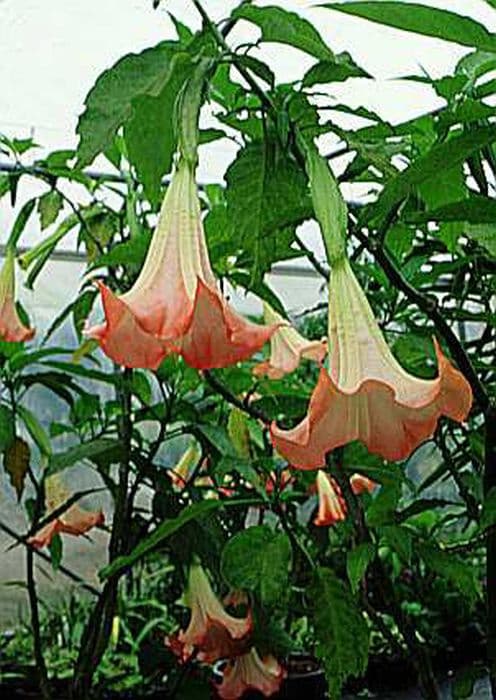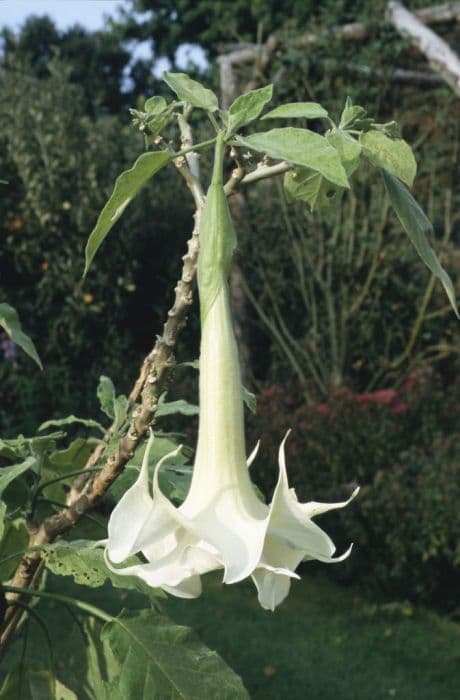Petunia Petunia Littletunia Andrew
![petunia [Littletunia Andrew]](/_next/image?url=https%3A%2F%2Fplants-admin.emdemapps.com%2Fimages%2Fplants%2F%2Fimages%2F604b559f92772.png&w=3840&q=75)
ABOUT
Petunia Littletunia Andrew is a vibrant flowering plant, known for its abundance of colorful blooms. The flowers are particularly striking with their trumpet-like shape which flares open at the mouth into five lobes. Each blossom showcases bold colors such as purple, pink, or blue, often with a contrasting color at the throat, creating a star-like pattern that serves as a beacon to pollinators. The petals tend to have a velvety texture, with subtle veins running through them, which may be lighter or darker than the main petal color. Around these stunning flowers, you'll find dark green leaves that are somewhat sticky to the touch and possess a slightly furry texture. These leaves are pointed at the tips and have smooth edges, providing a lush backdrop to the vibrant floral display. The overall aspect of the Petunia Littletunia Andrew is one of a dense, bushy plant with an inclination to spread, which contributes to its popular use in garden beds and containers where its cascading habit is highly valued. Its continuous blooming pattern throughout the growing season adds enduring beauty to any gardening space.
About this plant
 Names
NamesSynonyms
Littletunia Petunia, Mini Petunia, Calibrachoa-like Petunia.
Common names
Petunia Littletunia Andrew
 Toxicity
ToxicityTo humans
Petunias are generally considered non-toxic to humans. Therefore, ingestion of Petunia Littletunia Andrew is not likely to cause poisoning or serious health issues. While they are not poisonous, eating plant material could potentially lead to mild gastrointestinal discomfort due to the unusual content not typically present in a human diet. It's always best to avoid ingesting ornamental plants.
To pets
Petunias, including Petunia Littletunia Andrew, are generally recognized as non-toxic to both cats and dogs. These plants are not known to cause serious harm if pets ingest them. Symptoms of poisoning are unlikely; however, mild gastrointestinal upset could occur if a pet eats a significant amount of petunia plant material, as their digestive systems are not adapted for processing large quantities of vegetative matter, especially ornamentals.
 Characteristics
CharacteristicsLife cycle
Annuals
Foliage type
Deciduous
Color of leaves
Green
Flower color
Varies
Height
6-10 inches (15-25 cm)
Spread
10-14 inches (25-35 cm)
Plant type
Herb
Hardiness zones
9
Native area
South America
Benefits
 General Benefits
General Benefits- Easy to Grow: Adaptability to various growing conditions makes it easy for beginners.
- Vibrant Colors: Adds visual appeal to gardens with its variety of vivid flower colors.
- Continuous Blooming: Produces flowers continuously throughout the growing season.
- Low Maintenance: Requires minimal care beyond regular watering and occasional fertilizing.
- Attracts Pollinators: Attracts bees and butterflies, supporting local ecosystems.
- Versatility: Suitable for borders, containers, hanging baskets, and as ground cover.
- Drought Tolerance: Once established, it can tolerate brief periods of drought.
- Fast Growing: Quickly fills in garden spaces providing a lush appearance.
- Deer Resistance: Less likely to be eaten by deer than other garden plants.
 Medical Properties
Medical PropertiesThis plant is not used for medical purposes.
 Air-purifying Qualities
Air-purifying QualitiesThis plant is not specifically known for air purifying qualities.
 Other Uses
Other Uses- Artistic Dye: Petunias can provide a natural source of pigment for dyes to color fabrics and other materials, with potential for creating unique patterns and shades.
- Photography Prop: The vibrant colors and delicate structure of petunias make them an ideal subject for macro and nature photography, enhancing composition and aesthetic appeal.
- Educational Tool: Petunias can be used in schools to teach children about plant biology, life cycles, and the importance of horticulture.
- Literary Inspiration: Writers and poets may find the beauty and variety of petunias evocative, leading to their inclusion in creative texts as symbols or motifs.
- Icing Decoration: Petal fragments of petunias can be crystallized with sugar and used to embellish cakes and desserts for a floral touch.
- Floral Perfume: Though not a traditional usage, experimentation with petunia scent extraction may lead to unique notes for homemade fragrances.
- Thematic Events: Petunias can be featured in garden parties or social events as part of the theme, with their colors shaping the event's visual design.
- Greeting Cards: Pressed petunias can adorn handmade paper or greeting cards, giving them a three-dimensional and personal element.
- Ephemeral Art: Artists may choose to incorporate petunias in temporary installations or land art, where the decaying process is part of the artistic experience.
- Color Inspiration: Petunias' range in hues can serve as a palette for interior designers, artists, and fashion designers looking for color combinations and trends.
Interesting Facts
 Feng Shui
Feng ShuiThe Petunia is not used in Feng Shui practice.
 Zodiac Sign Compitability
Zodiac Sign CompitabilityThe Petunia is not used in astrology practice.
 Plant Symbolism
Plant Symbolism- Resentment and Anger: Petunias sometimes represent feelings of resentment or anger due to their moderately invasive nature and the ease with which they spread.
- Desire to Spend Time Together: Giving petunias may also express a desire to spend time with someone because petunias are often used in communal spaces like public gardens and parks.
- Comforting Presence: The petunia's lush foliage and comforting presence in gardens can symbolize the presence of a comforting and reassuring companion.
- Soothing of Emotions: With their wide range of colors and pleasant appearance, petunias are also seen as a way to soothe negative emotions or offer tranquility in times of stress.
 Water
WaterPetunias like the 'Petunia Littletunia Andrew' variety prefer consistent moisture but do not do well with overwatering, so it's crucial to ensure their soil is well-drained. Generally, watering once a week with about one to one and a half gallons of water should suffice. However, during periods of high heat or if the plant is in a container, you may need to water more frequently, possibly every few days, to keep the soil consistently moist. It’s important to water deeply and directly on the soil, avoiding wetting the foliage to prevent diseases. Monitor the top inch of the soil; if it feels dry to the touch, it’s time to water again.
 Light
LightPetunias, including the 'Petunia Littletunia Andrew', thrive in full sun. They need at least six hours of direct sunlight daily to flourish and produce a bountiful display of flowers. The best spot for these plants is a location where they will receive uninterrupted sunshine, often a southern or western exposure. If grown indoors, placing them by a sunny window can help meet their light requirements. However, some light afternoon shade can be beneficial in extremely hot climates.
 Temperature
TemperaturePetunias, such as the 'Petunia Littletunia Andrew', perform best in moderate temperatures and can endure a temperature range from about 40°F to 90°F. Ideally, they prefer growing in conditions where daytime temperatures are between 60°F and 75°F. While they can survive slight dips below the 40°F mark, they are not frost-tolerant and should be protected from cold snaps. Extended exposure to temperatures above 90°F can stress the plants and cause blooming to slow down or stop.
 Pruning
PruningPetunias like the 'Petunia Littletunia Andrew' require occasional pruning to encourage bushier growth and more blooms. Regularly deadheading, or removing faded flowers, stimulates the plant to produce new flowers. Additionally, lightly pruning back leggy stems every few weeks can help maintain a compact shape. The best time for more significant pruning is midseason, which gives the plant time to recover and put out fresh growth for a late summer to fall resurgence of blooms.
 Cleaning
CleaningAs needed
 Soil
SoilPetunias prefer a well-draining soil mix with peat moss, perlite, and compost. Ideal pH is slightly acidic to neutral, between 6.0 and 7.0.
 Repotting
RepottingPetunias, like Petunia Littletunia, typically need repotting every year to refresh the soil and accommodate root growth.
 Humidity & Misting
Humidity & MistingPetunias thrive in moderate humidity conditions, aiming for a relative humidity level around 40-50%.
 Suitable locations
Suitable locationsIndoor
Place in bright, indirect light and keep soil moist.
Outdoor
Full sun, well-draining soil, regular watering.
Hardiness zone
9-11 USDA
 Life cycle
Life cycleThe life of the Petunia 'Littletunia Andrew,' commonly known simply as Petunia, begins with seed germination, which occurs in warm, moist soil where the seeds sprout and develop into seedlings. The seedlings grow into vegetative plants with abundant foliage and a robust root system. After a period of vegetative growth, the plants enter the flowering stage, where they produce vibrant, trumpet-shaped flowers that attract pollinators. Following pollination, the flowers develop into seed capsules, which eventually dry and release seeds, completing the cycle. The parent plant may die after setting seed if it's an annual variety, or it may enter a period of dormancy if it's a perennial before beginning the cycle again with new growth in the next growing season. During its lifecycle, a petunia plant may also be propagated vegetatively through cuttings, leading to the creation of genetically identical offspring.
 Propogation
PropogationPropogation time
Spring-Summer
Petunia 'Littletunia Andrew', commonly known as Petunia, is typically propagated through seed sowing. The most popular method involves starting the seeds indoors 6 to 8 weeks before the last frost date to ensure they have a strong start. To do so, sprinkle the tiny seeds onto the surface of moist soil in a seed-starting tray or flat, and lightly press them into the soil without covering them, as they require light to germinate. Keep the soil consistently moist and maintain a temperature of around 70 to 75 degrees Fahrenheit (21 to 24 degrees Celsius). Seeds usually germinate within 7 to 10 days. Once seedlings emerge, provide plenty of light by placing the tray near a sunny window or under grow lights to prevent them from becoming leggy. When seedlings are large enough to handle and after the risk of frost has passed, they can be transplanted outdoors.


![Calibrachoa [Aloha Classic Blue Sky]](/_next/image?url=https%3A%2F%2Fplants-admin.emdemapps.com%2Fimages%2Fplants%2F%2Fimages%2F604b636c3778b.png&w=640&q=75)
![Calibrachoa [Aloha Classic Gold]](/_next/image?url=https%3A%2F%2Fplants-admin.emdemapps.com%2Fimages%2Fplants%2F%2Fimages%2F604b6284c573e.png&w=640&q=75)
![Calibrachoa [Aloha Classic Tiki Soft Pink]](/_next/image?url=https%3A%2F%2Fplants-admin.emdemapps.com%2Fimages%2Fplants%2F%2Fimages%2F604b548e0a5ef.png&w=640&q=75)
![Calibrachoa [Cabaret Deep Yellow]](/_next/image?url=https%3A%2F%2Fplants-admin.emdemapps.com%2Fimages%2Fplants%2F%2Fimages%2F604b5f20ca3ef.png&w=640&q=75)
![Calibrachoa [Calibasket Radiant Orange]](/_next/image?url=https%3A%2F%2Fplants-admin.emdemapps.com%2Fimages%2Fplants%2F%2Fimages%2F604b536d43cb2.png&w=640&q=75)
![Calibrachoa [Caloha Classic Blue Velvet]](/_next/image?url=https%3A%2F%2Fplants-admin.emdemapps.com%2Fimages%2Fplants%2F%2Fimages%2F604b604884a75.png&w=640&q=75)
![Calibrachoa [Caloha Classic Honey White]](/_next/image?url=https%3A%2F%2Fplants-admin.emdemapps.com%2Fimages%2Fplants%2F%2Fimages%2F604b5f56e0beb.png&w=640&q=75)
![Calibrachoa [Caloha Classic Yellow Chocolate Ring]](/_next/image?url=https%3A%2F%2Fplants-admin.emdemapps.com%2Fimages%2Fplants%2F%2Fimages%2F604b538aede95.png&w=640&q=75)